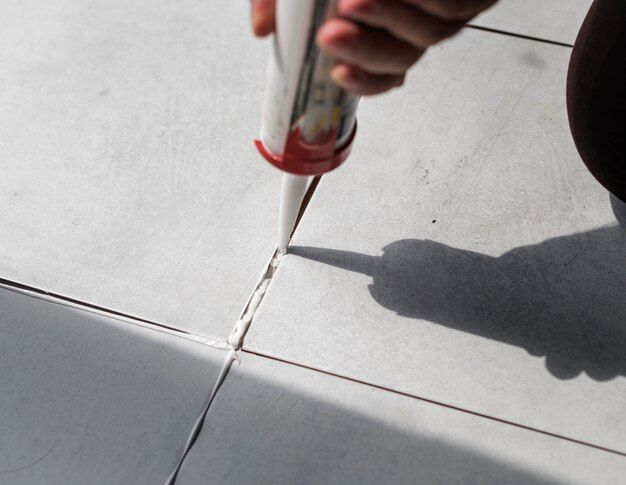Sealing a basement floor after painting is an important consideration for any homeowner. There are several factors to weigh when deciding if you need to apply a sealer or not. In this article, we will examine the pros and cons of sealing, look at what types of sealers are recommended, and provide tips on how to apply a sealer properly after painting a basement floor. Read on to get the information you need to make an informed decision about sealing your basement floor after painting.
Page Contents
Should You Seal a Painted Basement Floor?
There are several benefits to sealing a painted basement floor:
- Sealing helps protect the paint and concrete from moisture damage.
- It makes the surface easier to clean and maintain over time.
- Sealers can prevent stains from absorbing into the concrete.
- They provide an added layer of protection that can reduce wear and tear.
However, sealing is not strictly necessary in all cases. Here are some factors to consider when deciding if you should seal a painted basement floor:
- Will the basement be used frequently as living space? High-traffic areas benefit more from sealing.
- Is moisture or flooding an issue? Sealers provide extra protection.
- Do you want to buff the paint’s sheen? A sealer can enhance glossiness.
- Is the concrete relatively new and in good condition? Older or heavily pitted floors need more protection.
- Are you painting with epoxy paint? Epoxy coatings are quite durable on their own.
In most cases, sealing a painted basement floor is recommended. The relatively low cost and added protection make it worth considering. However, for very lightly used basements painted with epoxy, sealing may not be strictly necessary.
Types of Basement Floor Sealers
Three main types of sealers are commonly used for basement floors:
Acrylic Sealers
Acrylic sealers provide good protection at an affordable price. They form a flexible, breathable film on the surface. Acrylics sealers help resist moisture, stains, and wear while allowing vapor transmission. This prevents moisture from getting trapped under the coating. Acrylics are easy to apply, fast drying, and clean up with water. However, they provide less durability compared to other options.
Epoxy Sealers
Epoxy floor sealers are extremely durable and create a high-gloss, professional finish. Epoxies provide superior stain, chemical, and wear resistance. They also effectively seal out moisture. However, epoxy application can be tricky, and the fumes are strong during application. Epoxy sealers are more expensive than other options but provide the most complete protection.
Polyurethane Sealers
Polyurethane sealers offer excellent durability, chemical resistance, and abrasion protection. Polyurethane forms a tough, plastic-like coating that stands up well to heavy foot traffic. It provides excellent resistance to moisture, stains, mildew, and UV light. Polyurethane offers a good mid-range option between affordable acrylics and high-performance epoxies. The fumes can be strong during application.
When selecting a sealer, consider factors like cost, application difficulty, odor, and needed durability. In most home use cases, an acrylic or polyurethane sealer will provide sufficient protection. Epoxy is best for industrial settings or decorated flooring.
How to Apply a Basement Floor Sealer
Follow these key steps to properly seal your basement floor after painting:
- Allow the paint to cure fully before applying any sealer. Check the paint manufacturer’s recommendations, but most paints need 1-2 weeks to cure and harden completely before sealing.
- Thoroughly clean the floor first to remove any dirt, debris, grease or wax. Sweep then mop using a degreasing cleaner. Rinse well and allow to fully dry.
- Patch any cracks or divots in the concrete with an appropriate filler product. This provides a smoother surface for the sealer to adhere to.
- Select your sealer and apply according to the manufacturer’s directions. Carefully follow all instructions related to surface prep, testing, priming, application method, and dry time.
- For most sealers, use a roller or brush to apply a thin first coat. Once that dries, apply a second coat for complete coverage and protection. Too thick of a coat can lead to issues like bubbles or poor curing.
- Maintain air flow in the space for several days as most sealers will have some odor during the curing process. Install ventilation like fans to allow for ample air circulation.
- Let the sealer fully cure as directed before allowing any heavy foot traffic or moving furniture back into the space.
Applying a clear coat sealer after painting your basement floor helps prolong the life of the paint job and protects the concrete underneath. Carefully following the product directions ensures you achieve an even, durable coating. Resealing may be needed periodically in high traffic areas to maintain maximum protection. Investing in sealing after painting is well worth the time and cost.
Conclusion
Sealing a basement floor after painting provides many benefits that make it a recommended practice in most cases. The right sealer helps protect the paint itself from moisture, stains, cracks, and wear. It provides a barrier that keeps the porous concrete underneath from absorbing liquid spills or excessive dampness. Acrylic, polyurethane, and epoxy formulas each offer different advantages. Following the manufacturer’s instructions for proper prep work, application, dry time, and ventilation ensures the sealer adheres well and provides long-lasting protection. While not mandatory, taking the time to add a sealer over your finished paint job is highly advised to maintain the look and integrity of your basement flooring.
